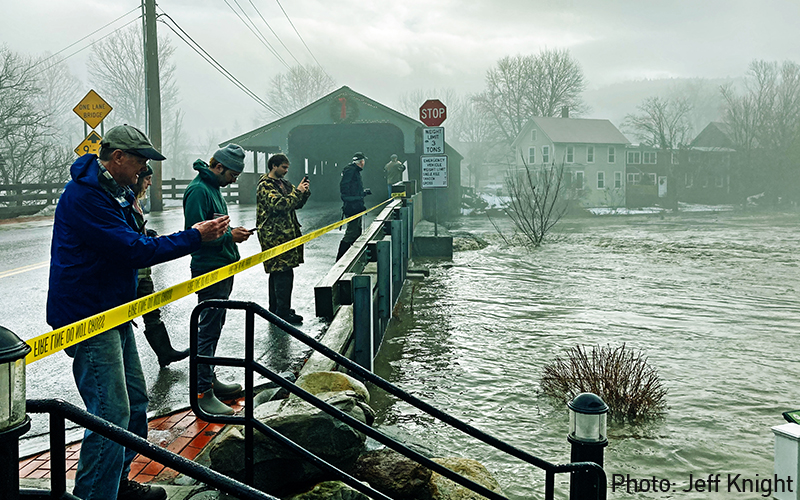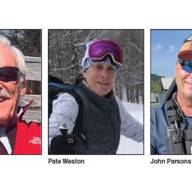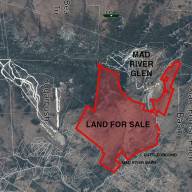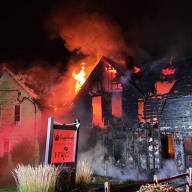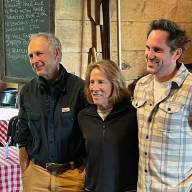On January 31, experts and community organizers gathered at Warren Elementary School to share their experiences from recent flood events, as well as their visions for flood prevention and recovery going forward. It was the final event in a series on flood resiliency hosted by Friends of the Mad River (FMR).
The panel was moderated by FMR executive director Ira Shadis.
LOCAL NETWORKS
The panel focused heavily on community efforts that emerged in the aftermath of 2023 flood events. Tara Reese, community director of Civic Standard in Hardwick, said that after the July floods, her organization partnered with the town of Hardwick and other community groups. Collectively, they organized a large clean-up effort, delivering meals to volunteers as they worked. That outreach is still ongoing, with the organization currently serving meals to 60 volunteers each week.
Reese said that whether a town is dealing with flood recovery, homelessness, inequality, or other issues, reaching out directly to those in need of assistance, as well as those who might be able to provide assistance, is key. In Hardwick’s case, she said that “what mattered was knowing our neighbors, and knowing that they had someone to trust, who was also working with the town.”
Katie, Trautz, executive director of the nonprofit Montpelier Alive, said that after 140 downtown Montpelier businesses were devastated by July flooding, the organization assembled 4,000 volunteers who were assigned to over 8,000 locations and tasks over the course of the following weeks. She said that volunteers included those involved in state hazard mitigation, those who could design digital mapping tools, and even local historians with knowledge of the river’s history.
Trautz said that assembling teams before the flooding happens and staying engaged with them over time is critical.
INEQUITABLE RECOVERY
Trautz also said that access to quickly-distributed funding is essential, as state and federal funding – including unemployment payments, tend to trickle in slowly. Montpelier Alive partnered with Montpelier Foundation immediately after July flooding, raising, and granting $2 million to local businesses and others affected in the following months.
It would be ideal for towns to keep reserve funding for flood recovery, she added, as “it really was not an equitable recovery.” Immigrant and refugee populations could not access much of the federal and state funding that was available, and had a harder time navigating those processes.
AVOIDING RIVER CLEAN-UP
The panel also touched on the impacts of flooding on local ecologies. Shayne Jacquith, a water restoration program manager for a Vermont chapter of the Nature Conservancy, urged people to refrain from tidying up rivers after flood events – leaving logs, rocks, and other debris in place to function as cover for various wildlife species.
Of fish, beavers, and other creatures – “what they don’t handle well, is rivers that look like driveways – where there’s no wood in them, or no boulders in them,” Will Eldridge, an aquatic habitat biologist at the Vermont Department of Fish and Wildlife, said, “That’s where the fish will have nowhere to hide. That’s where they get washed out and don’t come back.”
Eldridge added that fish species in the Mad River are currently doing well because they have so many hiding places.
“We often feel the need, and do have the need – from a social-economic perspective oftentimes, to go in and put the river back the way it was before the flood,” Jacquith said. “But the greatest impact to our natural communities happens not from the flood events themselves, but from those actions that we take to go put the rivers back after those events.”
CURBING DEVELOPMENT
Jacquith spoke about the need to stop developing in open lands surrounding rivers so that the land can better hold flood waters. He pointed to a bill in the Vermont Senate (S.213) that would more tightly regulate development in river corridors. Until legislation like this passes at the state level, he said that towns can adopt flood hazard regulations of their own – perhaps taking language from the bylaws of the Department of Environmental Conservation (DEC) Rivers Program.
Jacquith said that tighter regulation on flood plain development would protect home owners and renters. Michele Braun, executive director of Friends of the Winooski River, said that people often oppose this idea due to the current lack of affordable housing, “but that is just saying ‘let’s put our most vulnerable people in the most dangerous place.”
Jacquith, who previously worked in flood recovery with the DEC, recalled standing with someone who was watching his severely flood-damaged home being torn down by an excavator after Tropical Storm Irene in 2011. “It was a very intense experience standing with this individual as he was watching his memories being put into a big trash container.”
“If there’s one thing I find tragic,” he said, “it’s young families buying homes in risky areas because they’re the only affordable houses. It’s a problem that we continue to pass down to generations.”
BEAVERS AS ENGINEERS
A resident in the audience offered an additional idea for the prevention of future flooding: “The obvious natural solution, for free,” she said, “is beavers.”
Many experts say that beaver dams can reduce the risk of flooding by slowing down the flow of water, as well as reducing the volume of water that flows. That, in turn, can reduce erosion along river banks.
Eldridge agreed, calling beavers “ecosystem engineers.”
“This continent was one big soggy wetland before the fur trappers came through and really decimated the beaver populations,” he said – which culminated in the early 17th century.
“There is an awakening going on, globally,” Jacquith said,” with respect to the importance of beavers, and the extent to which they’ve really created this landscape in many ways.”
Braun said that overall, she has witnessed how flood events have made people more curious about waterways and local ecologies. “There’s a lot of processing trauma still happening for sure,” she said, “but just the level of interest in learning more and understanding more, is really encouraging.”


